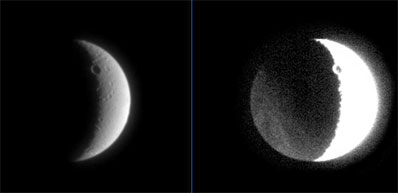
Spaceflight Now +

|

|

|

|

Premium video content for our Spaceflight Now Plus subscribers.

Titan up close
 Scientists reveal stunning pictures of Saturn's moon Titan and other results during this news conference from July 3. (38min 17sec file) Scientists reveal stunning pictures of Saturn's moon Titan and other results during this news conference from July 3. (38min 17sec file)
 Play video Play video

Saturn ring pictures
 Cassini's stunning close-up images of the rings around Saturn, taken just after the craft entered orbit Thursday morning, are presented with expert narration by Carolyn Porco, the mission imaging team leader. (8min 39sec file) Cassini's stunning close-up images of the rings around Saturn, taken just after the craft entered orbit Thursday morning, are presented with expert narration by Carolyn Porco, the mission imaging team leader. (8min 39sec file)
 Play video Play video

 Become a subscriber Become a subscriber
 More video More video

|

|

|

|

|

|

Cassini shows the dark side of Saturn's moon Dione
CASSINI PHOTO RELEASE
Posted: July 19, 2004
The icy, cratered surface of Saturn's moon Dione shows more than just its sunlit side in these two processed versions of the same image.

Credit: NASA/JPL/Space Science Institute
Download a larger image version here
|
The view at left, with only mild enhancement, shows a romantic crescent with large craters visible. The contrast in the version at the right has been greatly enhanced to show the side of Dione lit faintly by reflected light from Saturn. A similar phenomenon can be seen from Earth, when the Moon's dark side is visible due to "earthshine." The crater at the top of the image appears to have a sunlit central peak in the enhanced view -- a common characteristic of craters on Dione as seen in Voyager images. Slight variations in brightness on the moon's dark side hint at the bright curved linear streaks, seen by Voyager. These streaks are thought to be deposits of water ice.
The image was taken with the Cassini spacecraft narrow angle camera on July 2, 2004, from a distance of about 1.4 million kilometers (860,000 thousand miles) from Dione, at a Sun-Dione-spacecraft, or phase angle of about 119 degrees. The image scale is 8 kilometers (5 miles) per pixel. Dione's diameter is 1,118 kilometers (695 miles) across. The images have been magnified by a factor of two to aid visibility.
The Cassini-Huygens mission is a cooperative project of NASA, the European Space Agency and the Italian Space Agency. The Jet Propulsion Laboratory, a division of the California Institute of Technology in Pasadena, manages the Cassini-Huygens mission for NASA's Office of Space Science, Washington, D.C. The Cassini orbiter and its two onboard cameras, were designed, developed and assembled at JPL. The imaging team is based at the Space Science Institute, Boulder, Colo.
|

|

|

|
|



